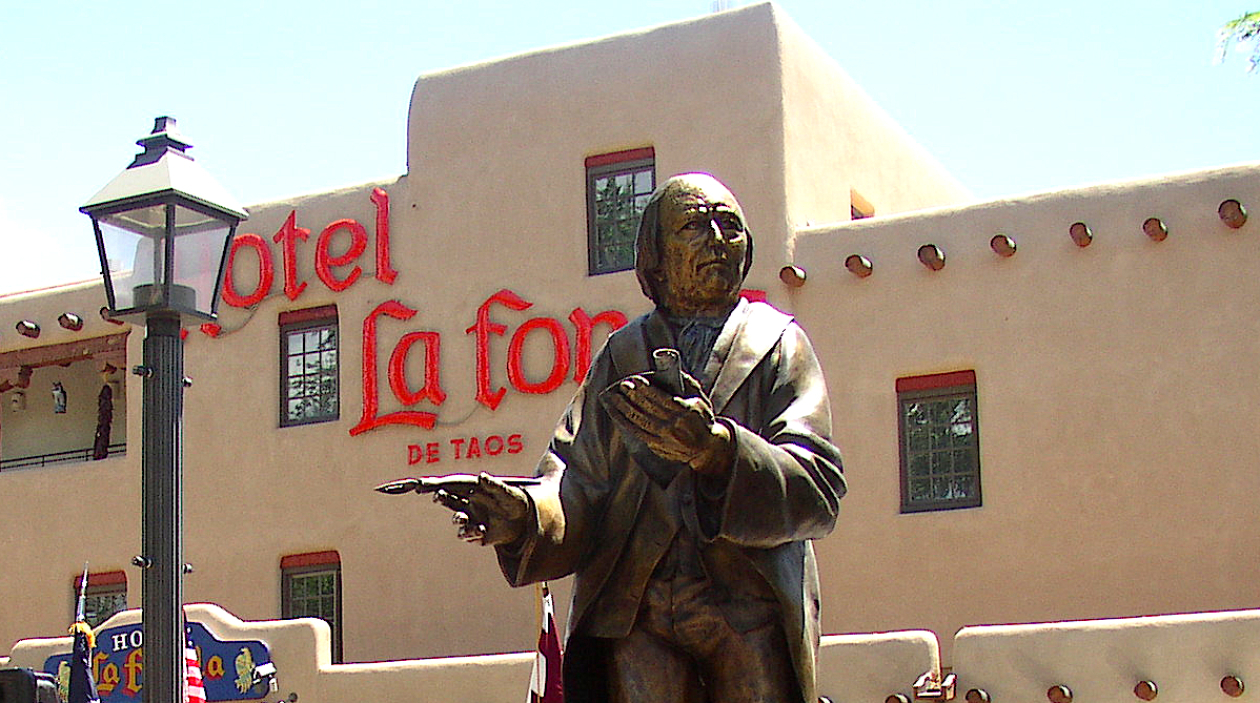Padre Martinez was in charge of la iglesia de Nuestra Señora de Guadalupe in Taos, New Mexico from 1826 until 1858. When he was first assigned there, it was an asistencia of the main parish church of San Geronimo located at the nearby Taos Pueblo. Guadalupe Church did not formally gain parish status until 1842. Nevertheless, it is one of the oldest churches dedicated to Mary under the title of Our Lady of Guadalupe that is continually functioning as a Catholic church (now for over two centuries) in the United States.
The first Guadalupe Church in Taos was constructed around 1802 at the La Plaza de Don Fernando. It fell into serious disrepair, but was used until 1911 when it was replaced by another building in time for New Mexico statehood in early 1912. [My two older brothers–Airforce Major J. Tobias Romero (retired) and Rev. C. Gilbert Romero, Ph. D. were baptized at that venerable church.] That church was sadly destroyed by fire in the summer of 1961 a few months after joyful ordination of Father Gilbert, fifty years ago this past April 25.] A third church, phoenix-like, rose from its ashes within a year and located across the road from the original location.
I have served as a priest at three different California parishes dedicated to Our Lady of Guadalupe: one in Santa Barbara, another in La Habra, and more recently in Palm Springs. Precisely one hundred years ago today, the leadership of the Agua Caliente Band of Cahuilla Indians in Palm Springs signed a document with twelve signatures thereby donating choice land to the Diocese of San Diego to be used for worship. The church built on that land is today’s Guadalupe Church in Palm Springs. Congratulations on the Centennial!
According to the story of Guadalupe, Mary appeared to the Indian Juan Diego a few consecutive times towards the end of 1531. Very early in the morning of December 12, she appeared again and encouraged this unschooled and yet unbaptized catechumen and urged him to take her message to Bishop Zumaraga that a church in her honor be built on the spot upon which she was appearing. It was Tepeyac Hill in today’s Mexico City. The actual location was the site of the goddess Tonantzin, goddess of fertility sacred to the Aztecs.
Just as Blessed Mary “took over” the cult that had been rendered to Artemis in Ephesus (Cf. Acts 19:23, sq.), so also does Mary under the title of Guadalupe take over the cult that had been rendered to Tonantzin. In Catholic theology, Mary is not a goddess, but is the mother of Jesus Christ true God as well as true man. He was “conceived by the Holy Spirit and born of the Virgin Mary,” as the Apostle’s Creed states. Therefore, she can rightfully be called the “Mother of God.”
Only ten years after the noche triste of 1521 that inaugurated the Spanish conquest, Mary appeared in the center of the new world—the American continent– not as a Spaniard nor as an Indian, but as the mestiza (racially mixed) brown virgin. “Am I not your mother?” she assures Juan Diego, and then invited him to be her ambassador before the Bishop.
Catholic faithful and others (Catholics who are not so “faithful” as well as many non-Catholics, including some non Christians) have a devotion to the mother of Jesus especially under the title of Guadalupe. To Spanish ears, that name sounded like a name already familiar to them. At the Monastery of Guadalupe in Extramadura, home to many of the conquistadores, there was a “black Virgin” widely venerated. However, the similar-sounding word in Nahuatl is translated as “she who crushes the head of the serpent”–understood as a reference to Genesis 3:15. This biblical citation is “The First Good News” or Protoevangelium. Immediately after the fall of Adam and Eve, God spoke to Satan in the form of the serpent and told him that the offspring of the woman (Eve) would crush the head of the serpent, but in the process, the “offspring” of the serpent would in turn wound the heel of the woman’s offspring’s. This text was the earliest foundation for messianic HOPE that prophets, speaking in the name of the Lord, helped to specify. Christian interpretation of that text understands “the woman’s offspring” first of all as the human race (Eve is “mother of all the living”), then as the Jewish people, and finally as Jesus Christ, son of David, son of Mary, Son of God.
In the middle of the Basilica of Guadalupe, the imprint of Mary’s image on Juan Diego’s tilma is preserved and venerated as a holy icon. It is appropriately flanked by the the flags of every nation of the continent of America. Mexico City is the approximate geographical center of the continent of the new world. My confrere Father Virgil Elizondo likes to point out, “Just as Mary of Nazareth gave birth to Jesus Christ in Bethlehem, so also Mary of Nazareth–with her apparitions to Juan Diego– gave birth to Jesus Christ in the new world of America.” She is the primary evangelizer of America, the continent.
